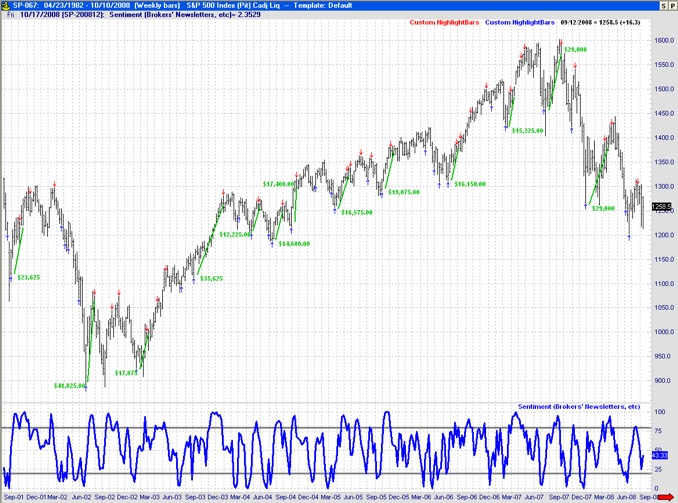Using market sentiment to guide trading
October/12/2008 22:48 Filed in: Fundamentals
I will try to answer selected email questions sent by readers of this blog directly on the blog. Due to time constrains I will try to answer between one and three questions per week. A reader of the blog sent me the following question based on the blog entry “Are the brokers, newsletters, and sentiment always wrong?” written on October 10, 2008:
>> “So if I just do the opposite of market sentiment, I'll make lots of $?! That's a nice simple algorithm.”
For those of you with mathematical background I will say that sentiment is typically a necessary condition to excellent buy or sell opportunities but it is not sufficient one. We need other setup techniques to confirm the setup, an entry technique, and an exit technique before we can say we have a trading strategy.
However, the short answer is that even with sentiment alone you are likely to do significantly better than the general public trying to time the market (most people trying to time the market based on news do very poorly and loose money). We use sentiment as one of our six indicators to analyze setup conditions on specific markets. Once we identify that the market is setup (using commercials, large traders, small traders, valuation, seasonality, sentiment, etc), then we still need to go to the daily charts and use a proper entry technique to enter the market and an exit technique to take out the profits.
The chart below shows how we would have done trading the S&P 500 if we had enter the market every time market sentiment went from having been very low to just crossing above the 20% line (i.e. 80% of the brokers, newsletters, etc are recommending “sell, sell, sell”) and exit once sentiment crossed below the 80% line (i.e. 80% of the brokers, newsletters, etc are recommending “buy, buy, buy”). The condition was programmed and the markers appear automatically on the chart as blue up arrows (buy signal) and red down arrows (sell signal). I also show a sample of the profits we would have made if we were trading one contract of the S&P500 future ($17,318.00). Note that we had many trades since 2001 that made 100% profit (i.e. a return of $17,328.00 on an $17,328.00). The reality, however, is that the trading account would need to be larger than $17,328.00 -otherwise we would be risking 100% of it in every trade. We will discuss the concept of “risk-of-ruin” in future entries and on the members area since its is a very important concept for sound money management.

>> “So if I just do the opposite of market sentiment, I'll make lots of $?! That's a nice simple algorithm.”
For those of you with mathematical background I will say that sentiment is typically a necessary condition to excellent buy or sell opportunities but it is not sufficient one. We need other setup techniques to confirm the setup, an entry technique, and an exit technique before we can say we have a trading strategy.
However, the short answer is that even with sentiment alone you are likely to do significantly better than the general public trying to time the market (most people trying to time the market based on news do very poorly and loose money). We use sentiment as one of our six indicators to analyze setup conditions on specific markets. Once we identify that the market is setup (using commercials, large traders, small traders, valuation, seasonality, sentiment, etc), then we still need to go to the daily charts and use a proper entry technique to enter the market and an exit technique to take out the profits.
The chart below shows how we would have done trading the S&P 500 if we had enter the market every time market sentiment went from having been very low to just crossing above the 20% line (i.e. 80% of the brokers, newsletters, etc are recommending “sell, sell, sell”) and exit once sentiment crossed below the 80% line (i.e. 80% of the brokers, newsletters, etc are recommending “buy, buy, buy”). The condition was programmed and the markers appear automatically on the chart as blue up arrows (buy signal) and red down arrows (sell signal). I also show a sample of the profits we would have made if we were trading one contract of the S&P500 future ($17,318.00). Note that we had many trades since 2001 that made 100% profit (i.e. a return of $17,328.00 on an $17,328.00). The reality, however, is that the trading account would need to be larger than $17,328.00 -otherwise we would be risking 100% of it in every trade. We will discuss the concept of “risk-of-ruin” in future entries and on the members area since its is a very important concept for sound money management.
